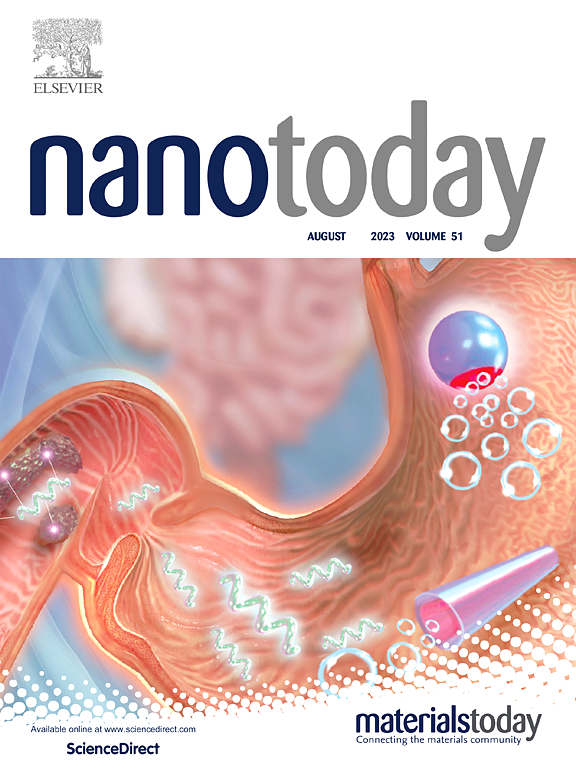Electronic cloud-regulation strategy enabling rapid and sensitive near-infrared detection of ONOO⁻ for dynamic monitoring of ferroptosis-mediated drug-induced liver injury
IF 10.9
1区 材料科学
Q1 CHEMISTRY, MULTIDISCIPLINARY
引用次数: 0
Abstract
Drug-induced liver injury (DILI) is caused by hepatotoxic effects resulting from drug metabolism. Extensive studies have demonstrated a close association between DILI progression and ferroptosis, a process characterized by redox imbalance triggered by lipid peroxidation. As a key product of redox imbalance and a critical biomarker of DILI, peroxynitrite (ONOO-) plays a pivotal regulatory role in ferroptosis. To elucidate the precise mechanism of ONOO- in ferroptosis-mediated DILI, there is an urgent need for ONOO- fluorescent probes with high specificity, sensitivity and signal-to-noise ratio. This study innovatively modified the traditional pyridine hemicyanine fluorophore into a quinoline hemicyanine structure, achieving a red-shifted fluorescence emission wavelength through extended conjugation and enhanced electron delocalization. Systematic site screening identified diphenyl phosphate ester as the optimal reaction site, demonstrating exceptional specificity, sensitivity and 75 s response characteristics. By conjugating the optimized fluorophore with the reaction site via nucleophilic substitution, we successfully developed a novel ratiometric fluorescent probe, zt-4. Given the remarkable similarities in pathological mechanisms (including signaling pathways, regulatory nodes, and biomarkers) between osteoarthritis (OA) and DILI, we first validated the imaging performance of zt-4 in a complex inflammatory OA Model. Subsequently, we applied probe zt-4 to analyze ferroptosis-mediated DILI model at both cellular and murine levels. For the first time, our study revealed that the ferroptosis pathway dynamically regulates ONOO- levels in DILI, elucidating its molecular mechanism. These findings provide new theoretical foundations and intervention strategies for DILI treatment.
电子云调节策略,实现ONOO的快速和灵敏的近红外检测,用于动态监测铁中毒介导的药物性肝损伤
药物性肝损伤(DILI)是由药物代谢引起的肝毒性作用引起的。大量研究表明DILI进展与铁下垂密切相关,这一过程以脂质过氧化引发的氧化还原失衡为特征。作为氧化还原失衡的关键产物和DILI的重要生物标志物,过氧亚硝酸盐(ONOO-)在铁凋亡中起着关键的调节作用。为了阐明ONOO-在死铁介导的DILI中的确切机制,迫切需要具有高特异性、高灵敏度和高信噪比的ONOO-荧光探针。本研究创新性地将传统的吡啶半苯胺荧光团修饰为喹啉半苯胺结构,通过扩展共轭和增强电子离域实现了荧光发射波长的红移。系统的位点筛选确定磷酸二苯酯为最佳反应位点,表现出优异的特异性、敏感性和75 s的响应特性。通过亲核取代将优化的荧光团与反应位点偶联,我们成功地开发了一种新型的比例荧光探针zt-4。鉴于骨关节炎(OA)和DILI在病理机制(包括信号通路、调节节点和生物标志物)上的显著相似性,我们首先验证了zt-4在复杂炎性OA模型中的成像性能。随后,我们应用探针zt-4在细胞和小鼠水平上分析了铁中毒介导的DILI模型。本研究首次揭示了铁下垂途径动态调控DILI中ONOO-水平,阐明了其分子机制。这些发现为DILI的治疗提供了新的理论基础和干预策略。
本文章由计算机程序翻译,如有差异,请以英文原文为准。
求助全文
约1分钟内获得全文
求助全文
来源期刊

Nano Today
工程技术-材料科学:综合
CiteScore
21.50
自引率
3.40%
发文量
305
审稿时长
40 days
期刊介绍:
Nano Today is a journal dedicated to publishing influential and innovative work in the field of nanoscience and technology. It covers a wide range of subject areas including biomaterials, materials chemistry, materials science, chemistry, bioengineering, biochemistry, genetics and molecular biology, engineering, and nanotechnology. The journal considers articles that inform readers about the latest research, breakthroughs, and topical issues in these fields. It provides comprehensive coverage through a mixture of peer-reviewed articles, research news, and information on key developments. Nano Today is abstracted and indexed in Science Citation Index, Ei Compendex, Embase, Scopus, and INSPEC.
 求助内容:
求助内容: 应助结果提醒方式:
应助结果提醒方式:


